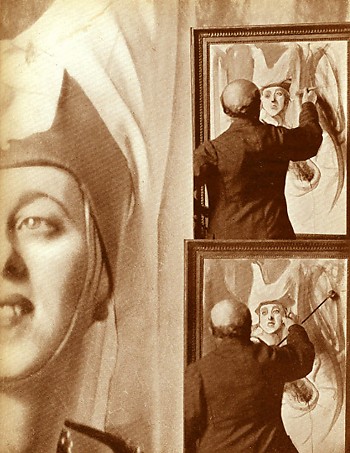 |
"Gwen Ffrangcon-Davies" by Philip de Laszlo
|
The
brilliant Hungarian artist, Philip Alexius de László,
1869-1937, was the successor (in 1907) to Sargent's portrait
practice in London. In 1933 de László demonstrated
his dashing technique in a series of photographs, while answering
questions posed by the writer A.L. Baldry. The photos and
text were published in 1934 by The Studio Publications of
London, in volume six of their "How to Do It" series.
6. Accessories
Q: What about the rest of the portrait, the draperies
and accessories, how do they rank in relative
importance?
"Most of what I have just said about the
manner in which hands and feet reveal personality
applies to the movement of the sitter's body and,
I repeat, rightness in recording that movement
is necessary for the making of a successful portrait.
There is, in the pose he adopts an unconscious
assertion of himself, and the way he wears his
clothes emphasizes this assertion. A woman's dress,
a man's uniform, robes or everyday suit fall into
lines on the sitters themselves quite different
from those they would take on any model or lay
figure and so you may fairly say that the arrangement
of the draperies must be seriously studied because
in it is seen a further revelation of character."
17. When to Stop
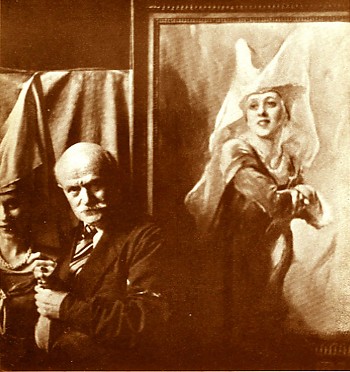 The
sitter, the
The
sitter, the
painter and the
completed por-
trait. In this
instance the
entire process
occupied only
eight and a half
hours.
Q: Is that why, as you put it, you develop
the general effect of your picture continuously?
"Yes; I say once more that by the time I
have finished the head I reckon to have brought
all the rest of the picture into harmony and right
relation with it without necessarily dwelling
upon the lesser details. That is the stage at
which this portrait of Miss Ffrangcon-Davies has
now arrived and there is, I think, no need to
carry it any further. It is an example of a type
of picture I often paint in which I concentrate
on the head and hands and leave the rest unelaborated
but, as nearly as possible, correct in forms and
values. Still, now that the head and hands are
finished, I could, if I wished, complete the draperies
and accessories with the help of a model or lay
figure, without losing the qualities of the picture,
because I have already painted all the main facts
of the draperies on the sitter. I might mention
that when I do paint a completely finished large
picture I endeavour to keep the draperies restrained
in tone so that, however rich the dress or uniform
and accessories may be, the attention of the spectator
is not diverted from the head and hands by any
over-insistence upon the incidentals."
Q: But surely your method is a little unusual.
Do many artists paint the draperies in their portraits
on the actual sitters?
"I really cannot tell you, but I am inclined
to think that a good many do not. You will often
see in a portrait that the head gives the impression
of not belonging to the body. This is generally
because the head has been painted throughout and
finished independently of the rest of the picture
and then the clothes on someone else's body have
been added to it. The result must almost inevitably
be a misfit, which is to be deplored. Of course,
the risk of over-tiring the sitter must be avoided
and for this reason I have always aimed at rapidity
and directness in my handling of the draperies
which the sitter wears. To paint a hand or foot
from a model and not from the sitter would be,
of course, unpardonable."
18. When a Fresh Start
is Necessary
Q: I can quite appreciate that rapidity and
directness are essential in all stages of work
like yours, but I can also imagine that if you
were not absolutely sure of yourself and knew
exactly what you meant to do they might easily
get out of control. What would happen if a picture
did not develop in the way that you intended?"
"Before I go into that I would like to point
out that no artist can ever be absolutely sure
of himself; even to pretend to think that he is
infallible would be a most dangerous form of conceit.
At no time can he afford to relax his effort to
acquire greater acuteness of vision and more complete
command over the technical processes of his craft.
Of course, because he is human, he will always
be liable to make mistakes, and he must constantly
be on his guard against them; and when they do
happen they must be frankly recognized and boldly
dealt with. I am convinced that when a piece of
work has gone wrong it is no good tinkering with
it and trying to pull it into shape. That only
makes things worse. For myself, if I am not content
with the way a portrait is developing, if from
the moment when I have made my first drawing I
cannot go straight ahead to a satisfactory finish,
I throw aside what I have done and begin again."
Q: What! Another picture on a fresh canvas?"
"What else? To find that I was not succeeding
in realizing my intention would mean that I could
no longer take pleasure in my work and decidedly
I should not feel inclined to waste my energies
on something that annoyed me. Besides, even if
I did fight my way out of the difficulty, all
the freshness and spontaneity of my picture would
be gone. With a fresh canvas I have a new problem
to solve and I can start with my way clear before
me. I have even, on occasions, discarded a half-finished
portrait and begun another because I chanced to
discover that my sitter had a more interesting
aspect that the one I had first chosen to paint.
It seems to me obvious that I should want his
portrait to show him at his best."
Q: Would it not be permissible sometimes to
improve on the original? For instance, when you
were painting a woman might you not idealize her
a little?
"Indeed, you surprise me! You are as bad
as a very mature lady who once asked me to paint
her, but insisted that I should make her look
like what she told me she had been when she was
twenty years younger."
Q: How amusing. Did you do it?
"Can you imagine my doing anything so ridiculous?
If I were so foolish as to start trying to improve
on nature what could I expect but an entirely
artificial and conventional result" In serious
portraiture there is no place either for what
you call idealizing or for that sort of caricature
which some people affect because they fancy that
a portrait gains in strength by over-accentuation
of the sitter's facial peculiarities. Very often
these peculiarities are wholly accidental and
have no significance whatever for the student
of the sitter's character, and by exaggerating
them a thoroughly false impression of his personality
might be given. The painter's mission is to find
and record intelligently the best and most characteristic
view of his sitter, not to make him look like
a freak."
Q: Do you think our modernist artists would
agree with you in that?
"To such a question I have nothing to reply.
I am not discussing the opinions of other people,
I am explaining to you what I believe. Whether
others do or do not agree with me has nothing
to do with the matter. I claim the right to think
for myself."
To be continued



















 The
sitter, the
The
sitter, the 
 Work
on
Work
on 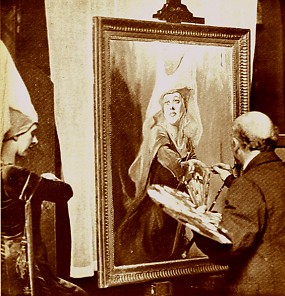
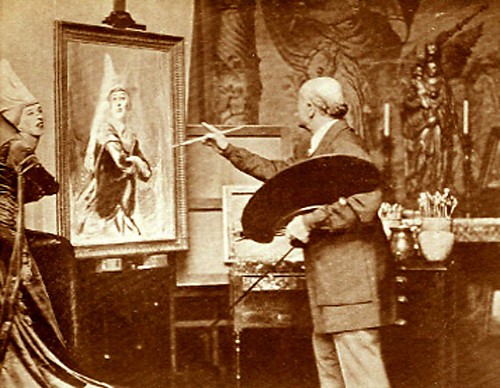


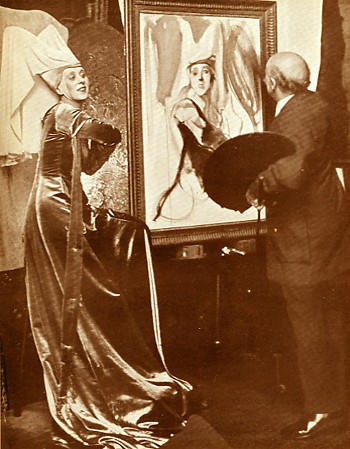 Developing
Developing
